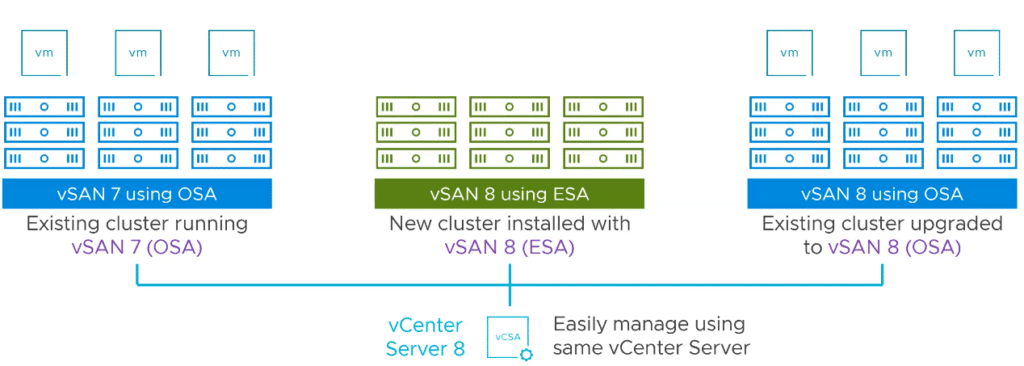The new hyper-converged infrastructure (HCI) architecture is designed to take full advantage of the capabilities available with the latest NVMe storage devices
Deployment models of vSAN8
- vSAN Original Storage Architecture (OSA)
- vSAN Express Storage Architecture (ESA)
vSAN Original Storage Architecture (OSA)
The classic storage architecture is the one with a dedicated cache and capacity drives available as a hybrid ( HDD+Flash ) or an all-flash configuration configured as disk groups. The same old concept of a dedicated cache tier that had to be allocated with the remainder of the disk configuration being configured for capacity or actual storage of our VM files is what the OSA provides. Existing clusters running on vSAN OSA models can be migrated to OSA vSAN 8.

vSAN Express Storage Architecture (ESA)
This one is optimized for purely NVMe drives and gets rid of the disk group configuration and uses storage pools. In the ESA model, all the devices in the pool contribute to the performance and capacity which is a massive improvement in storage utilization and performance as a whole.

Some of the Advantages of vSAN 8
vSAN 8 ESA has some great advantages over the OSA model.
- vSAN ESA eliminates Cache disks and Disk groups so that itself is a huge storage improvement.
- ESA offers improved CPU efficiency, improved availability with reduced failure domains, simplified storage device provisioning with proactive insights, and RAID-6 data storage with RAID-1 performance.
- Lower CPU usage per processed IO
- Highly Efficient Data Compression and encryption
- Snapshots with minimal performance impact
- Proactive notifications for environments not enrolled in the Customer Experience Improvement Program (CEIP) is available in both vSAN OSA and ESA deployments and this is quite handy for Limited Connectivity Environments that need health monitoring
- vSAN 8 has improved cache device size for the OSA model
Prerequisites for vSAN8
- vSAN 8 needs certified hardware to run – ESA-ready nodes.
- 4 NVMe devices per host.
- vSAN ESA requires advanced or enterprise licenses.
- No direct upgrade path from traditional vSAN OSA to ESA. VMs need to be migrated to ESA via sVMotion/vMotion. ESA and OSA clusters can coexist in the same vCenter.

Migrating Path to vSAN ESA
There is no direct upgrade path from vSAN 7 OSA to vSAN 8 Express Storage Architecture. VMware vSAN 7 (vSphere 7) can be upgraded in place to vSAN 8 (vSphere 8) with the original storage architecture (OSA).
- Stand up your new vSAN ESA Cluster.
- Apply vSAN Advanced or Enterprise Licensing
- Migrate your Virtual Machines with Storage vMotion without any downtime
- ESA and OSA clusters can coexist in the same vCenter.

